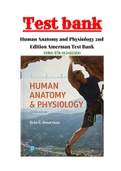Test bank
H u m a n A n a t o m y a n d P h y s i o l o g y 2 n d
E d i t i o n A m e r m a n T e s t B a n k
I S B N : 9 7 8 - 0 1 3 4 5 5 3 5 1 1 www.nursylab.com
www.nursylab.com Exam
Name___________________________________
MULTIPLE CHOICE. Choose the one alternative that best com pletes the statement or answers the question.
1)Learners who thrive in an environment with visual stimulation , such as looking at diagrams or
illustrations, have a preference for a modality known as:
A)visual. B)kinesthetic. C)auditory. D)tactile.1)
2)Sierra says she learns more from reading the textbook for class t han from listening to lecture. She is
most likely a(n):
A)auditory learner. B)tactile learner.
C)kinesthetic learner. D)visual learner.2)
3)Jesse felt comfortable using the microscope after listening to direc tions from his lab professor. His
learning style preference must be:
A)tactile learner. B)kinesthetic learner.
C)visual learner. D)auditory learner.3)
4)What does the SQ3R method stand for?
A)survey, question, read, recite, and review
B)search, quiet, research, read, and remember
C)share, quiz, query, question, and read
D)sort, query, read, recite, and review4)
5)Why should a student use the SQ3R method?
A)The SQ3R method provides a student with a strategy for taki ng notes during lecture class.
B)The SQ3R method provides a student with ways to improve time mana gement skills.
C)The SQ3R method provides a student with a strategy for impr oving test taking skills.
D)The SQ3R method provides a plan for a student to improve textb ook reading skills.5)
6)What is a good way to manage time in preparation for your a natomy and physiology class?
A)I study only on the weekends when I have many hours of free time.
B)I should stay up all night the night before the test to maximiz e what is stored in short-term
memory.
C)I make a schedule and budget my time.
D)I should delay studying until the day or two before the test to best remember the material.6)
7)What learning modality is engaged when students participat e in study groups?
A)tactile learner B)kinesthetic learner
C)auditory learner D)visual learner7)
8)What is a good strategy for class or laboratory prepar ation?
A)Focus on reading your materials on the weekends when you have hours to spend.
B)Avoid reading before class as you may get confused.
C)Read and prepare notes before attending your class or laborator y.
D)Only read after you have attended class or laboratory.8)
1www.nursylab.com
www.nursylab.com 9)How could you use the Learning Outcomes in this book to help yo u study?
A)Write down the answers to the Learning Outcomes.
B)Read through the Learning Outcomes after you have completed a section .
C)Recite the Learning Outcomes until you have them memorized.
D)Rewrite each Learning Outcome in your notes.9)
10)What results when anabolism occurs more than catabolism in a n organism?
A)excretion B)movement C)growth D)irritability10)
11)What is the smallest level of structural organization in t he human body?
A)chemical level B)organ level C)tissue level D)cellular level11)
12)Which of the following is the most complex structural level of organization?
A)tissue level B)chemical level C)cellular level D)organ level12)
13)Which of the following is the correct sequence, from simplest to most complex, in the levels of
structural organization of the human body?
A)cellular level, tissue level, chemical level, organ level, organ s ystem level, organismal level
B)chemical level, tissue level, cellular level, organ system level , organ level, organismal level
C)chemical level, cellular level, tissue level, organ level, organ sy stem level, organismal level
D)cellular level, chemical level, tissue level, organ level, organ sys tem level, organismal level13)
14)In laboratory, you will study the overall structure and shap e of the femur bone without the aid of a
microscope. This is a study known as:
A)gross anatomy. B)microscopic anatomy.
C)systemic anatomy. D)regional anatomy.14)
15)In laboratory, you will study tissues. This area of study is known as:
A)histology. B)physiology. C)gross anatomy. D)cytology.15)
16)Which organ system supports the body and protects internal o rgans?
A)digestive system B)endocrine system
C)muscular system D)skeletal system16)
17)Which organ system includes blood vessels and the heart?
A)cardiovascular system B)lymphatic system
C)endocrine system D)respiratory system17)
18)Which two organ systems include the pancreas as a component?
A)endocrine and lymphatic systems B)digestive and urinary systems
C)digestive and endocrine systems D)respiratory and cardiovascular systems18)
19)What is a major function of the respiratory system?
A)return excess tissue fluid to the cardiovascular system
B)produce vitamin D and retain water
C)deliver oxygen to the blood and remove carbon dioxide from the body
D)digest food and absorb nutrients into the blood19)
2www.nursylab.com
www.nursylab.com




